Walter Ong's Theories on the Transition from Orality to Literacy
VerifiedAdded on 2022/08/12
|9
|2301
|18
Essay
AI Summary
This essay provides a comprehensive overview of Walter Ong's contributions to understanding the transition from orality to literacy and its impact on culture, consciousness, and communication. It examines Ong's key concepts, including primary and secondary orality, the influence of print culture, and the historical developments of visualist tendencies in Western philosophy. The essay explores Ong's analysis of how the shift from oral to literate societies has affected education, knowledge preservation, and human thought processes. It highlights his major works, such as "Orality and Literacy: The Technologizing of the Word," and discusses how his research has influenced fields like cultural history, philosophy, and communication studies. The essay emphasizes Ong's focus on the technological transformation of the word and its effects on oral traditions, literary forms, and social structures. It also touches upon the importance of his work in understanding the conservation of culture through communication.
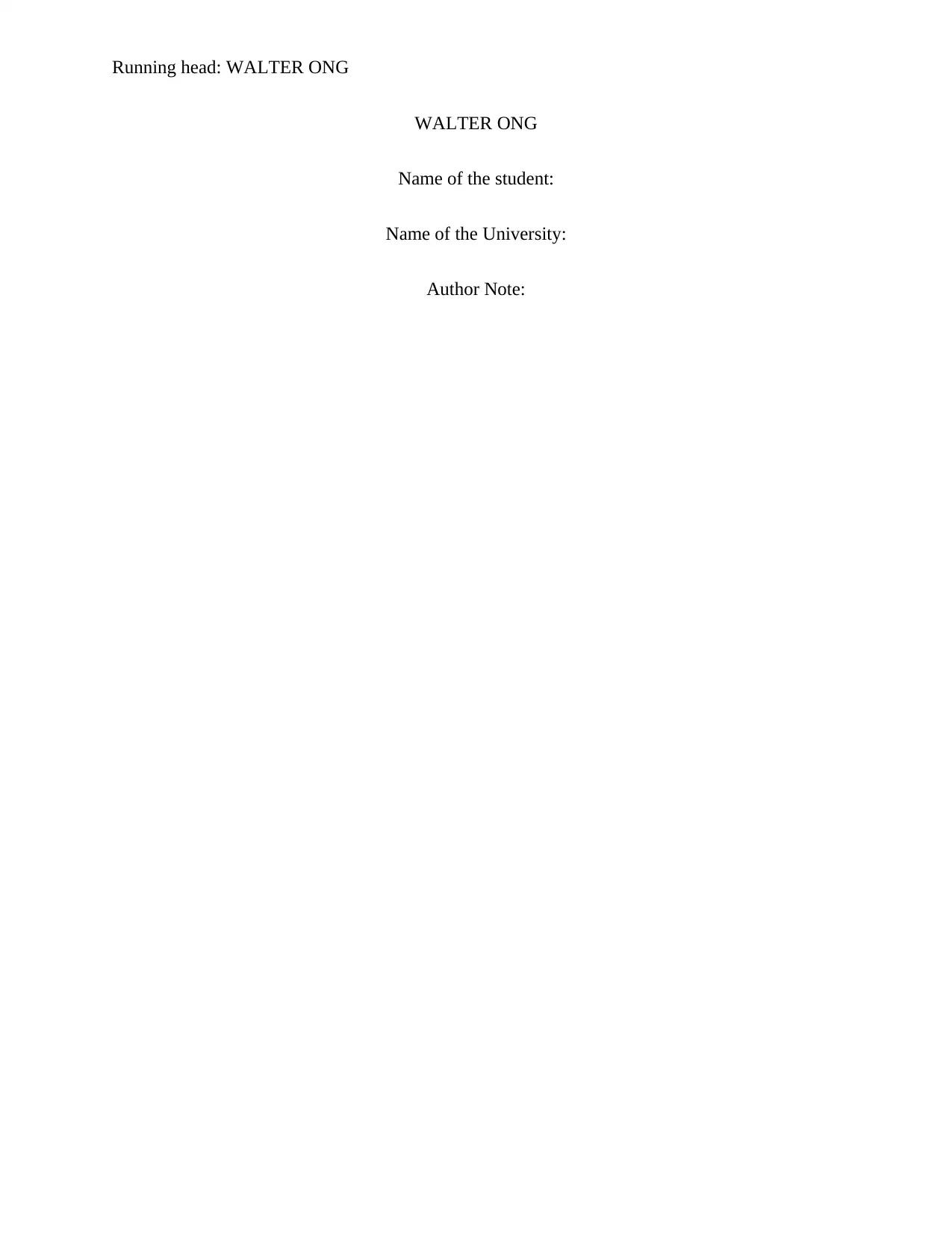
Running head: WALTER ONG
WALTER ONG
Name of the student:
Name of the University:
Author Note:
WALTER ONG
Name of the student:
Name of the University:
Author Note:
Paraphrase This Document
Need a fresh take? Get an instant paraphrase of this document with our AI Paraphraser
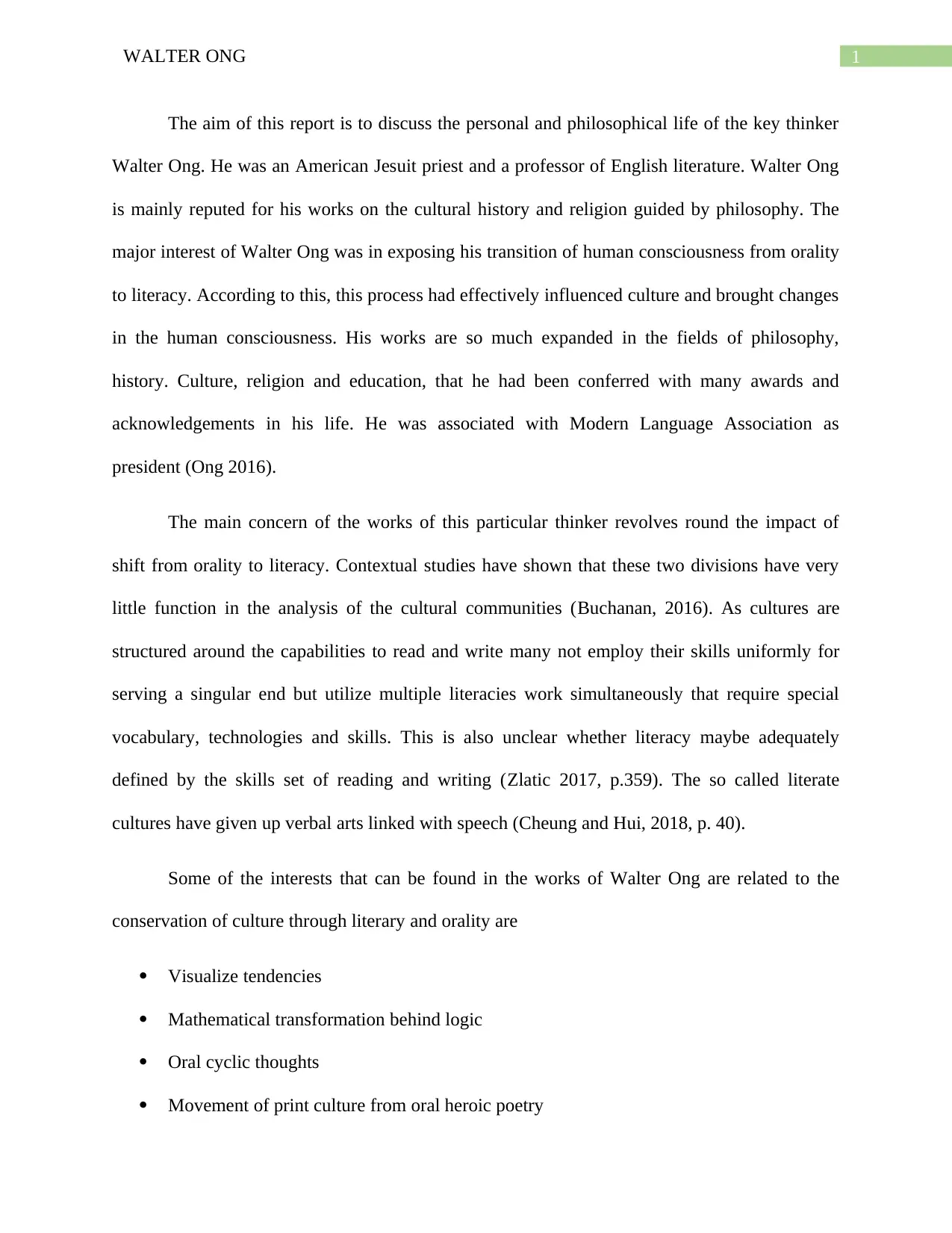
1WALTER ONG
The aim of this report is to discuss the personal and philosophical life of the key thinker
Walter Ong. He was an American Jesuit priest and a professor of English literature. Walter Ong
is mainly reputed for his works on the cultural history and religion guided by philosophy. The
major interest of Walter Ong was in exposing his transition of human consciousness from orality
to literacy. According to this, this process had effectively influenced culture and brought changes
in the human consciousness. His works are so much expanded in the fields of philosophy,
history. Culture, religion and education, that he had been conferred with many awards and
acknowledgements in his life. He was associated with Modern Language Association as
president (Ong 2016).
The main concern of the works of this particular thinker revolves round the impact of
shift from orality to literacy. Contextual studies have shown that these two divisions have very
little function in the analysis of the cultural communities (Buchanan, 2016). As cultures are
structured around the capabilities to read and write many not employ their skills uniformly for
serving a singular end but utilize multiple literacies work simultaneously that require special
vocabulary, technologies and skills. This is also unclear whether literacy maybe adequately
defined by the skills set of reading and writing (Zlatic 2017, p.359). The so called literate
cultures have given up verbal arts linked with speech (Cheung and Hui, 2018, p. 40).
Some of the interests that can be found in the works of Walter Ong are related to the
conservation of culture through literary and orality are
Visualize tendencies
Mathematical transformation behind logic
Oral cyclic thoughts
Movement of print culture from oral heroic poetry
The aim of this report is to discuss the personal and philosophical life of the key thinker
Walter Ong. He was an American Jesuit priest and a professor of English literature. Walter Ong
is mainly reputed for his works on the cultural history and religion guided by philosophy. The
major interest of Walter Ong was in exposing his transition of human consciousness from orality
to literacy. According to this, this process had effectively influenced culture and brought changes
in the human consciousness. His works are so much expanded in the fields of philosophy,
history. Culture, religion and education, that he had been conferred with many awards and
acknowledgements in his life. He was associated with Modern Language Association as
president (Ong 2016).
The main concern of the works of this particular thinker revolves round the impact of
shift from orality to literacy. Contextual studies have shown that these two divisions have very
little function in the analysis of the cultural communities (Buchanan, 2016). As cultures are
structured around the capabilities to read and write many not employ their skills uniformly for
serving a singular end but utilize multiple literacies work simultaneously that require special
vocabulary, technologies and skills. This is also unclear whether literacy maybe adequately
defined by the skills set of reading and writing (Zlatic 2017, p.359). The so called literate
cultures have given up verbal arts linked with speech (Cheung and Hui, 2018, p. 40).
Some of the interests that can be found in the works of Walter Ong are related to the
conservation of culture through literary and orality are
Visualize tendencies
Mathematical transformation behind logic
Oral cyclic thoughts
Movement of print culture from oral heroic poetry
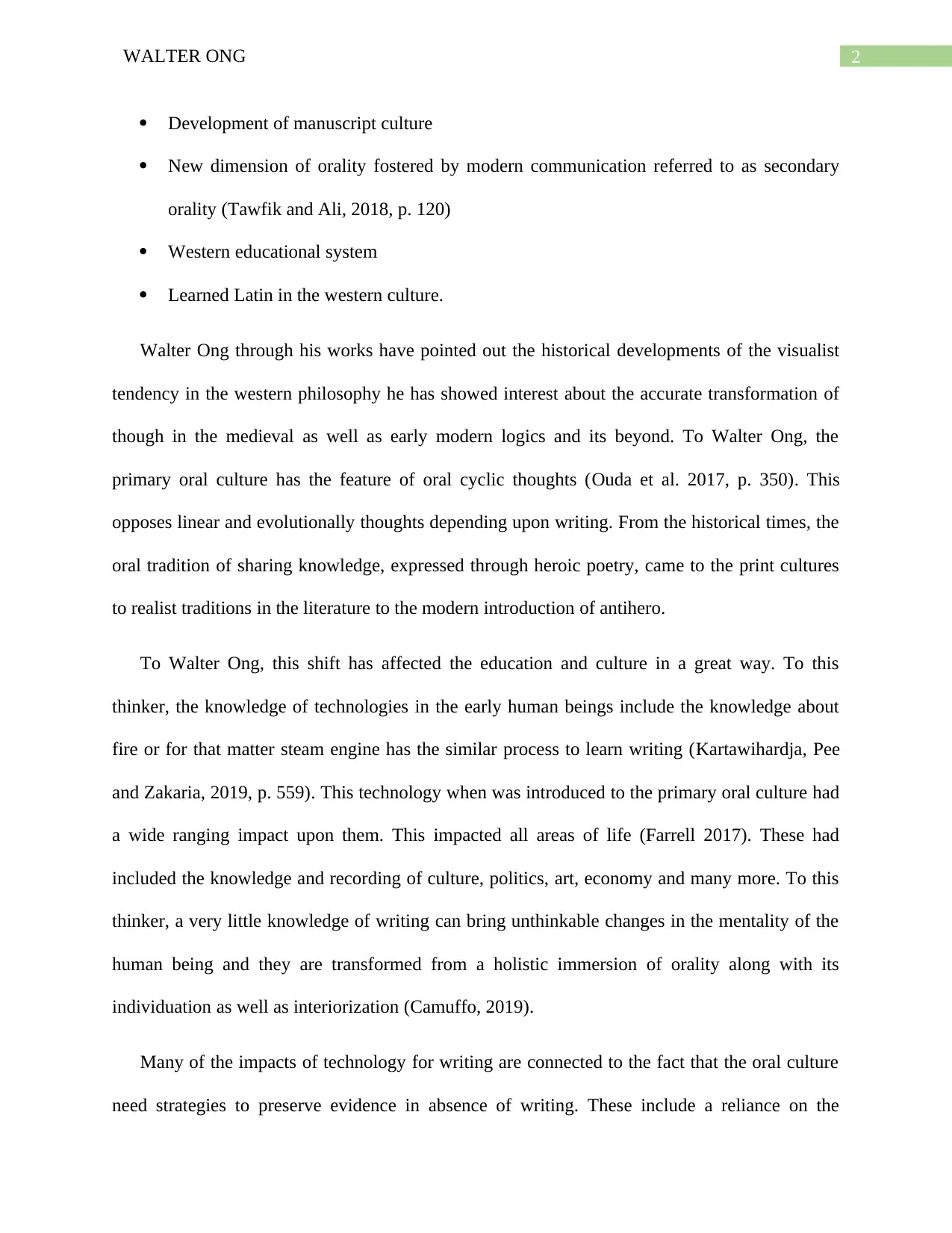
2WALTER ONG
Development of manuscript culture
New dimension of orality fostered by modern communication referred to as secondary
orality (Tawfik and Ali, 2018, p. 120)
Western educational system
Learned Latin in the western culture.
Walter Ong through his works have pointed out the historical developments of the visualist
tendency in the western philosophy he has showed interest about the accurate transformation of
though in the medieval as well as early modern logics and its beyond. To Walter Ong, the
primary oral culture has the feature of oral cyclic thoughts (Ouda et al. 2017, p. 350). This
opposes linear and evolutionally thoughts depending upon writing. From the historical times, the
oral tradition of sharing knowledge, expressed through heroic poetry, came to the print cultures
to realist traditions in the literature to the modern introduction of antihero.
To Walter Ong, this shift has affected the education and culture in a great way. To this
thinker, the knowledge of technologies in the early human beings include the knowledge about
fire or for that matter steam engine has the similar process to learn writing (Kartawihardja, Pee
and Zakaria, 2019, p. 559). This technology when was introduced to the primary oral culture had
a wide ranging impact upon them. This impacted all areas of life (Farrell 2017). These had
included the knowledge and recording of culture, politics, art, economy and many more. To this
thinker, a very little knowledge of writing can bring unthinkable changes in the mentality of the
human being and they are transformed from a holistic immersion of orality along with its
individuation as well as interiorization (Camuffo, 2019).
Many of the impacts of technology for writing are connected to the fact that the oral culture
need strategies to preserve evidence in absence of writing. These include a reliance on the
Development of manuscript culture
New dimension of orality fostered by modern communication referred to as secondary
orality (Tawfik and Ali, 2018, p. 120)
Western educational system
Learned Latin in the western culture.
Walter Ong through his works have pointed out the historical developments of the visualist
tendency in the western philosophy he has showed interest about the accurate transformation of
though in the medieval as well as early modern logics and its beyond. To Walter Ong, the
primary oral culture has the feature of oral cyclic thoughts (Ouda et al. 2017, p. 350). This
opposes linear and evolutionally thoughts depending upon writing. From the historical times, the
oral tradition of sharing knowledge, expressed through heroic poetry, came to the print cultures
to realist traditions in the literature to the modern introduction of antihero.
To Walter Ong, this shift has affected the education and culture in a great way. To this
thinker, the knowledge of technologies in the early human beings include the knowledge about
fire or for that matter steam engine has the similar process to learn writing (Kartawihardja, Pee
and Zakaria, 2019, p. 559). This technology when was introduced to the primary oral culture had
a wide ranging impact upon them. This impacted all areas of life (Farrell 2017). These had
included the knowledge and recording of culture, politics, art, economy and many more. To this
thinker, a very little knowledge of writing can bring unthinkable changes in the mentality of the
human being and they are transformed from a holistic immersion of orality along with its
individuation as well as interiorization (Camuffo, 2019).
Many of the impacts of technology for writing are connected to the fact that the oral culture
need strategies to preserve evidence in absence of writing. These include a reliance on the
⊘ This is a preview!⊘
Do you want full access?
Subscribe today to unlock all pages.

Trusted by 1+ million students worldwide
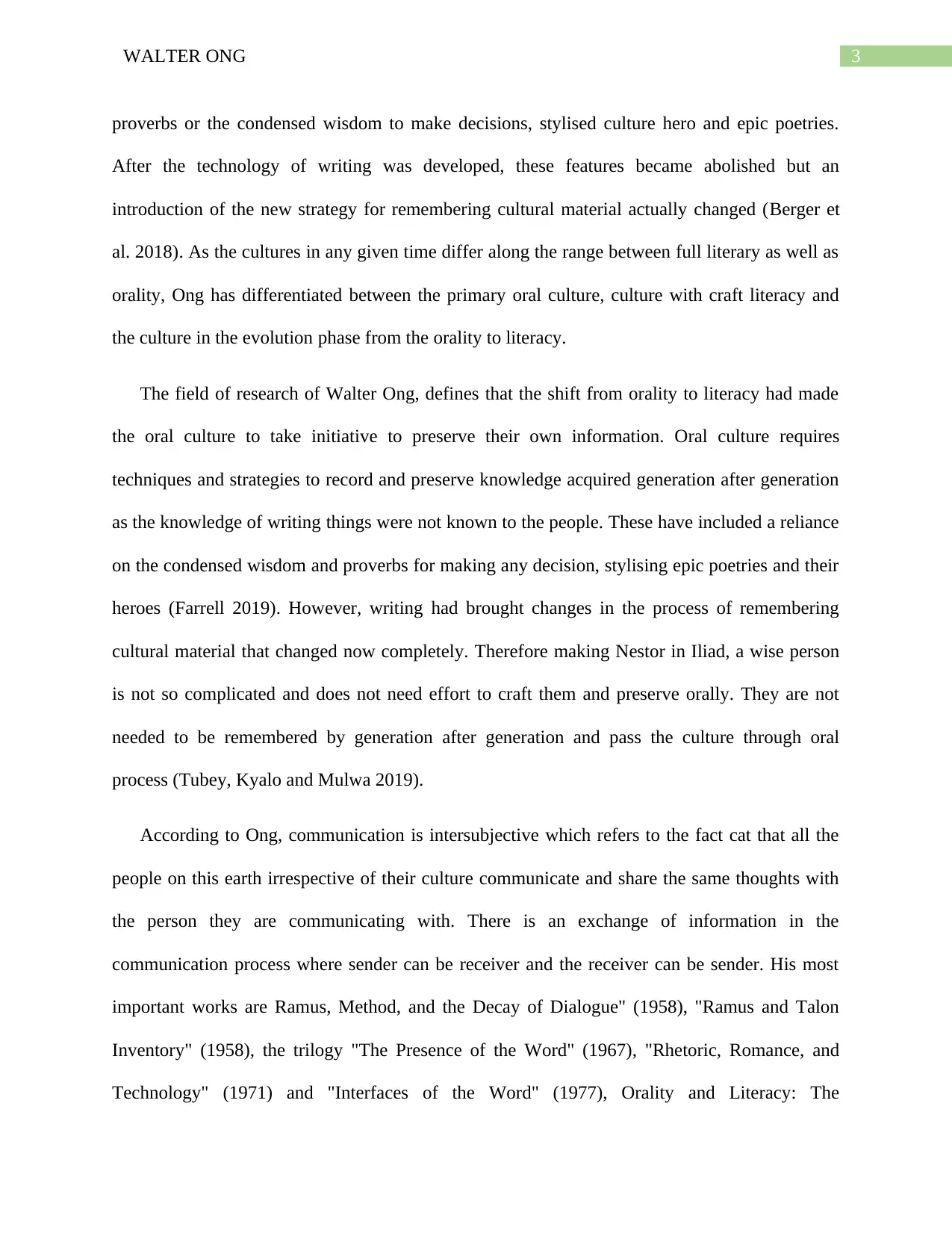
3WALTER ONG
proverbs or the condensed wisdom to make decisions, stylised culture hero and epic poetries.
After the technology of writing was developed, these features became abolished but an
introduction of the new strategy for remembering cultural material actually changed (Berger et
al. 2018). As the cultures in any given time differ along the range between full literary as well as
orality, Ong has differentiated between the primary oral culture, culture with craft literacy and
the culture in the evolution phase from the orality to literacy.
The field of research of Walter Ong, defines that the shift from orality to literacy had made
the oral culture to take initiative to preserve their own information. Oral culture requires
techniques and strategies to record and preserve knowledge acquired generation after generation
as the knowledge of writing things were not known to the people. These have included a reliance
on the condensed wisdom and proverbs for making any decision, stylising epic poetries and their
heroes (Farrell 2019). However, writing had brought changes in the process of remembering
cultural material that changed now completely. Therefore making Nestor in Iliad, a wise person
is not so complicated and does not need effort to craft them and preserve orally. They are not
needed to be remembered by generation after generation and pass the culture through oral
process (Tubey, Kyalo and Mulwa 2019).
According to Ong, communication is intersubjective which refers to the fact cat that all the
people on this earth irrespective of their culture communicate and share the same thoughts with
the person they are communicating with. There is an exchange of information in the
communication process where sender can be receiver and the receiver can be sender. His most
important works are Ramus, Method, and the Decay of Dialogue" (1958), "Ramus and Talon
Inventory" (1958), the trilogy "The Presence of the Word" (1967), "Rhetoric, Romance, and
Technology" (1971) and "Interfaces of the Word" (1977), Orality and Literacy: The
proverbs or the condensed wisdom to make decisions, stylised culture hero and epic poetries.
After the technology of writing was developed, these features became abolished but an
introduction of the new strategy for remembering cultural material actually changed (Berger et
al. 2018). As the cultures in any given time differ along the range between full literary as well as
orality, Ong has differentiated between the primary oral culture, culture with craft literacy and
the culture in the evolution phase from the orality to literacy.
The field of research of Walter Ong, defines that the shift from orality to literacy had made
the oral culture to take initiative to preserve their own information. Oral culture requires
techniques and strategies to record and preserve knowledge acquired generation after generation
as the knowledge of writing things were not known to the people. These have included a reliance
on the condensed wisdom and proverbs for making any decision, stylising epic poetries and their
heroes (Farrell 2019). However, writing had brought changes in the process of remembering
cultural material that changed now completely. Therefore making Nestor in Iliad, a wise person
is not so complicated and does not need effort to craft them and preserve orally. They are not
needed to be remembered by generation after generation and pass the culture through oral
process (Tubey, Kyalo and Mulwa 2019).
According to Ong, communication is intersubjective which refers to the fact cat that all the
people on this earth irrespective of their culture communicate and share the same thoughts with
the person they are communicating with. There is an exchange of information in the
communication process where sender can be receiver and the receiver can be sender. His most
important works are Ramus, Method, and the Decay of Dialogue" (1958), "Ramus and Talon
Inventory" (1958), the trilogy "The Presence of the Word" (1967), "Rhetoric, Romance, and
Technology" (1971) and "Interfaces of the Word" (1977), Orality and Literacy: The
Paraphrase This Document
Need a fresh take? Get an instant paraphrase of this document with our AI Paraphraser
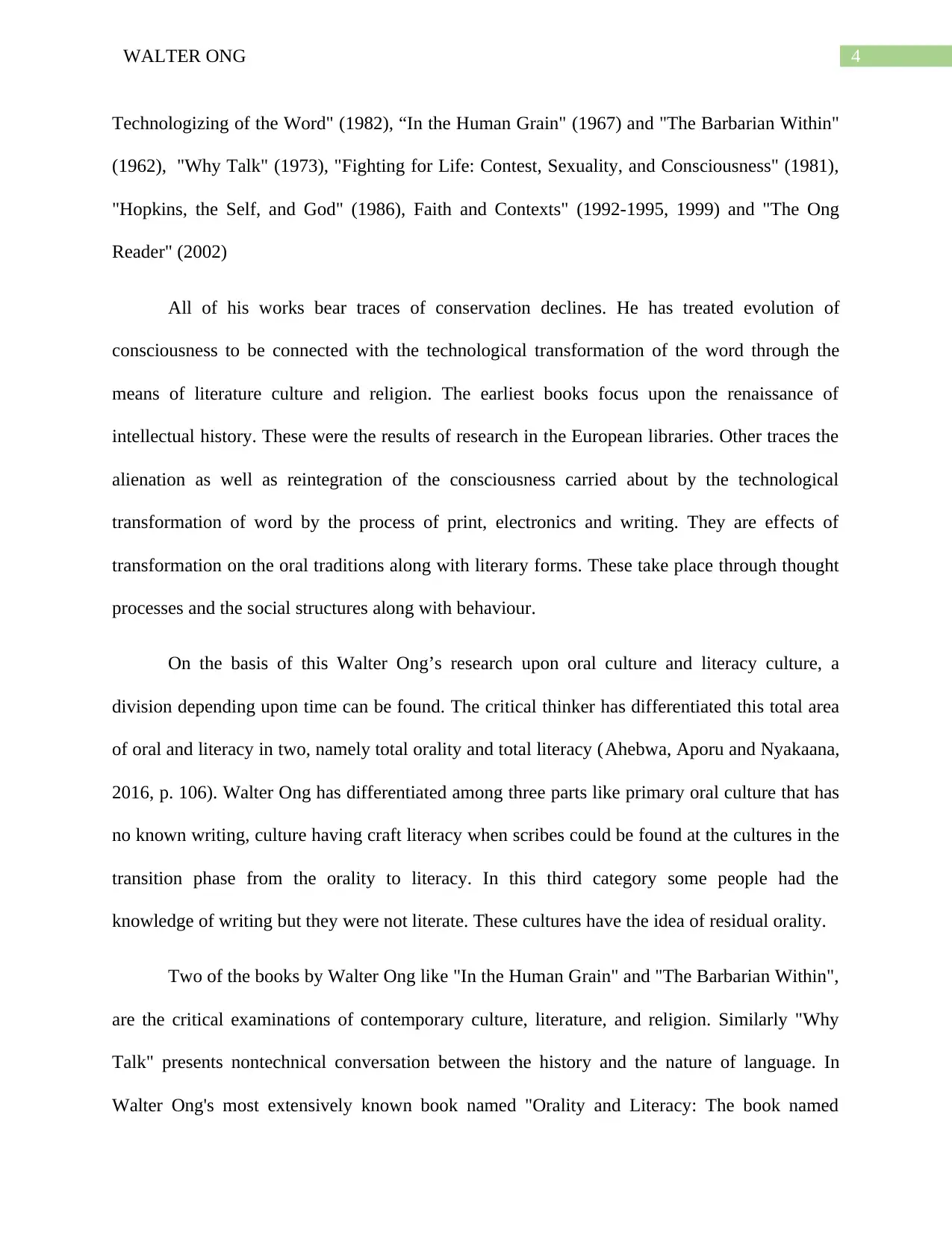
4WALTER ONG
Technologizing of the Word" (1982), “In the Human Grain" (1967) and "The Barbarian Within"
(1962), "Why Talk" (1973), "Fighting for Life: Contest, Sexuality, and Consciousness" (1981),
"Hopkins, the Self, and God" (1986), Faith and Contexts" (1992-1995, 1999) and "The Ong
Reader" (2002)
All of his works bear traces of conservation declines. He has treated evolution of
consciousness to be connected with the technological transformation of the word through the
means of literature culture and religion. The earliest books focus upon the renaissance of
intellectual history. These were the results of research in the European libraries. Other traces the
alienation as well as reintegration of the consciousness carried about by the technological
transformation of word by the process of print, electronics and writing. They are effects of
transformation on the oral traditions along with literary forms. These take place through thought
processes and the social structures along with behaviour.
On the basis of this Walter Ong’s research upon oral culture and literacy culture, a
division depending upon time can be found. The critical thinker has differentiated this total area
of oral and literacy in two, namely total orality and total literacy (Ahebwa, Aporu and Nyakaana,
2016, p. 106). Walter Ong has differentiated among three parts like primary oral culture that has
no known writing, culture having craft literacy when scribes could be found at the cultures in the
transition phase from the orality to literacy. In this third category some people had the
knowledge of writing but they were not literate. These cultures have the idea of residual orality.
Two of the books by Walter Ong like "In the Human Grain" and "The Barbarian Within",
are the critical examinations of contemporary culture, literature, and religion. Similarly "Why
Talk" presents nontechnical conversation between the history and the nature of language. In
Walter Ong's most extensively known book named "Orality and Literacy: The book named
Technologizing of the Word" (1982), “In the Human Grain" (1967) and "The Barbarian Within"
(1962), "Why Talk" (1973), "Fighting for Life: Contest, Sexuality, and Consciousness" (1981),
"Hopkins, the Self, and God" (1986), Faith and Contexts" (1992-1995, 1999) and "The Ong
Reader" (2002)
All of his works bear traces of conservation declines. He has treated evolution of
consciousness to be connected with the technological transformation of the word through the
means of literature culture and religion. The earliest books focus upon the renaissance of
intellectual history. These were the results of research in the European libraries. Other traces the
alienation as well as reintegration of the consciousness carried about by the technological
transformation of word by the process of print, electronics and writing. They are effects of
transformation on the oral traditions along with literary forms. These take place through thought
processes and the social structures along with behaviour.
On the basis of this Walter Ong’s research upon oral culture and literacy culture, a
division depending upon time can be found. The critical thinker has differentiated this total area
of oral and literacy in two, namely total orality and total literacy (Ahebwa, Aporu and Nyakaana,
2016, p. 106). Walter Ong has differentiated among three parts like primary oral culture that has
no known writing, culture having craft literacy when scribes could be found at the cultures in the
transition phase from the orality to literacy. In this third category some people had the
knowledge of writing but they were not literate. These cultures have the idea of residual orality.
Two of the books by Walter Ong like "In the Human Grain" and "The Barbarian Within",
are the critical examinations of contemporary culture, literature, and religion. Similarly "Why
Talk" presents nontechnical conversation between the history and the nature of language. In
Walter Ong's most extensively known book named "Orality and Literacy: The book named
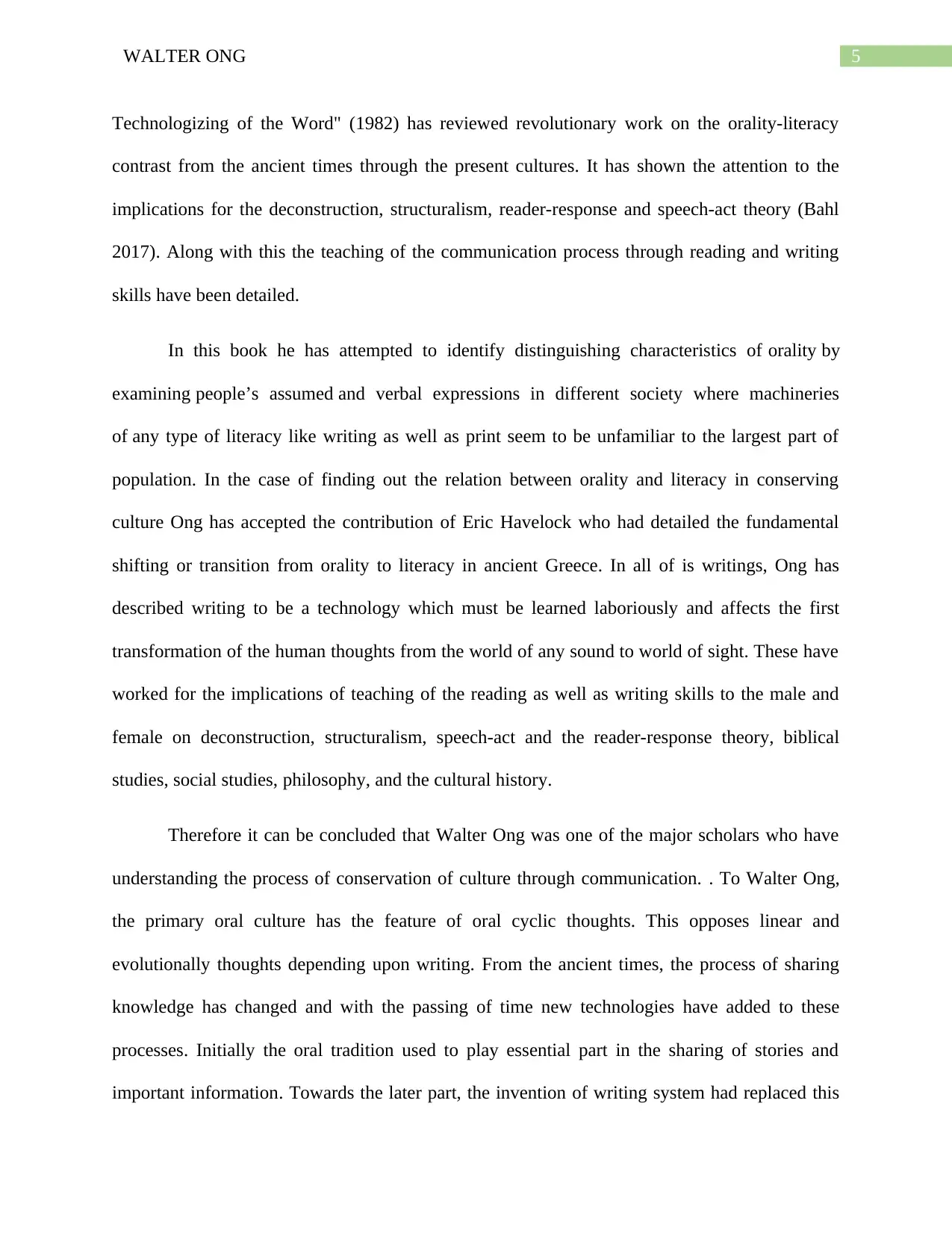
5WALTER ONG
Technologizing of the Word" (1982) has reviewed revolutionary work on the orality-literacy
contrast from the ancient times through the present cultures. It has shown the attention to the
implications for the deconstruction, structuralism, reader-response and speech-act theory (Bahl
2017). Along with this the teaching of the communication process through reading and writing
skills have been detailed.
In this book he has attempted to identify distinguishing characteristics of orality by
examining people’s assumed and verbal expressions in different society where machineries
of any type of literacy like writing as well as print seem to be unfamiliar to the largest part of
population. In the case of finding out the relation between orality and literacy in conserving
culture Ong has accepted the contribution of Eric Havelock who had detailed the fundamental
shifting or transition from orality to literacy in ancient Greece. In all of is writings, Ong has
described writing to be a technology which must be learned laboriously and affects the first
transformation of the human thoughts from the world of any sound to world of sight. These have
worked for the implications of teaching of the reading as well as writing skills to the male and
female on deconstruction, structuralism, speech-act and the reader-response theory, biblical
studies, social studies, philosophy, and the cultural history.
Therefore it can be concluded that Walter Ong was one of the major scholars who have
understanding the process of conservation of culture through communication. . To Walter Ong,
the primary oral culture has the feature of oral cyclic thoughts. This opposes linear and
evolutionally thoughts depending upon writing. From the ancient times, the process of sharing
knowledge has changed and with the passing of time new technologies have added to these
processes. Initially the oral tradition used to play essential part in the sharing of stories and
important information. Towards the later part, the invention of writing system had replaced this
Technologizing of the Word" (1982) has reviewed revolutionary work on the orality-literacy
contrast from the ancient times through the present cultures. It has shown the attention to the
implications for the deconstruction, structuralism, reader-response and speech-act theory (Bahl
2017). Along with this the teaching of the communication process through reading and writing
skills have been detailed.
In this book he has attempted to identify distinguishing characteristics of orality by
examining people’s assumed and verbal expressions in different society where machineries
of any type of literacy like writing as well as print seem to be unfamiliar to the largest part of
population. In the case of finding out the relation between orality and literacy in conserving
culture Ong has accepted the contribution of Eric Havelock who had detailed the fundamental
shifting or transition from orality to literacy in ancient Greece. In all of is writings, Ong has
described writing to be a technology which must be learned laboriously and affects the first
transformation of the human thoughts from the world of any sound to world of sight. These have
worked for the implications of teaching of the reading as well as writing skills to the male and
female on deconstruction, structuralism, speech-act and the reader-response theory, biblical
studies, social studies, philosophy, and the cultural history.
Therefore it can be concluded that Walter Ong was one of the major scholars who have
understanding the process of conservation of culture through communication. . To Walter Ong,
the primary oral culture has the feature of oral cyclic thoughts. This opposes linear and
evolutionally thoughts depending upon writing. From the ancient times, the process of sharing
knowledge has changed and with the passing of time new technologies have added to these
processes. Initially the oral tradition used to play essential part in the sharing of stories and
important information. Towards the later part, the invention of writing system had replaced this
⊘ This is a preview!⊘
Do you want full access?
Subscribe today to unlock all pages.

Trusted by 1+ million students worldwide
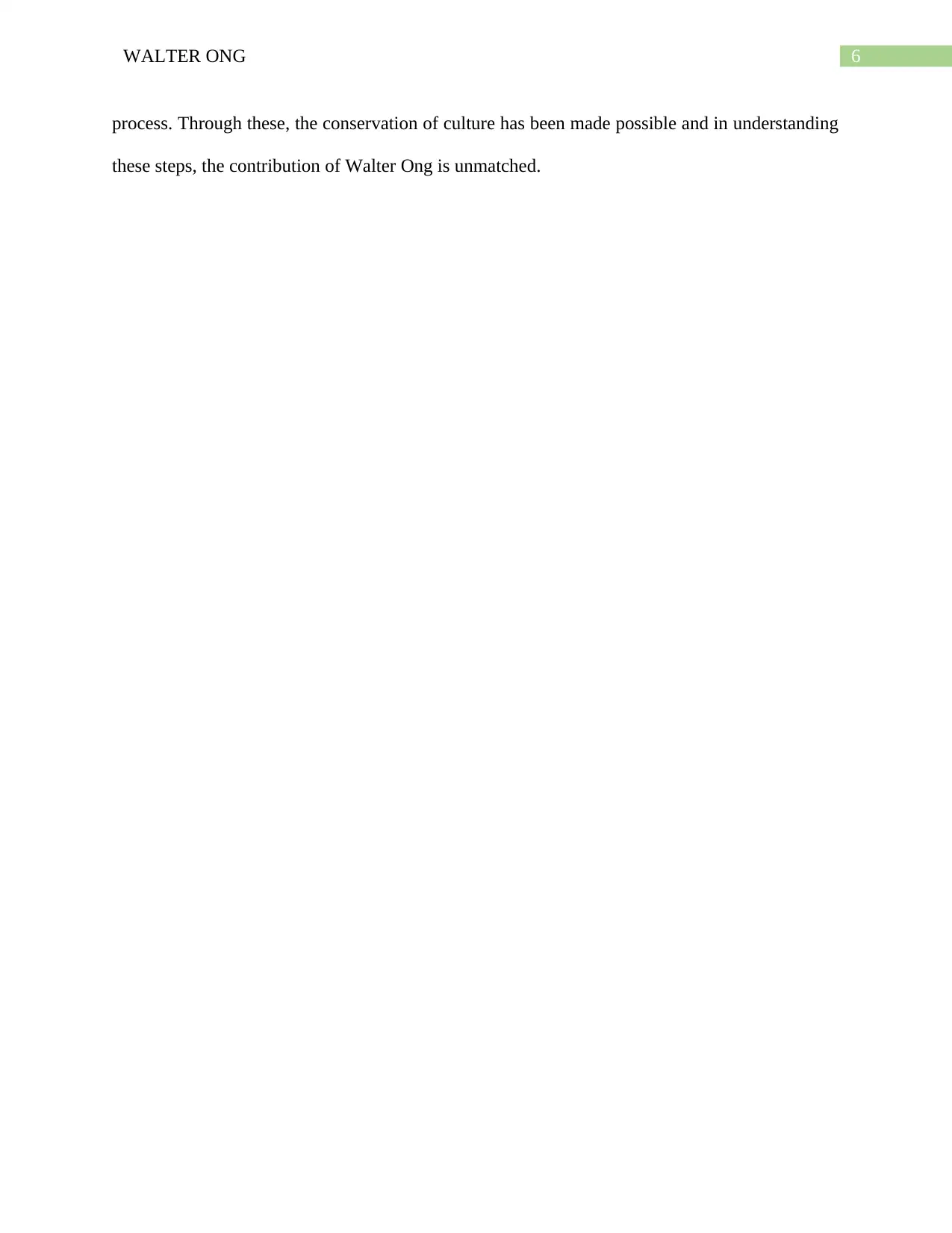
6WALTER ONG
process. Through these, the conservation of culture has been made possible and in understanding
these steps, the contribution of Walter Ong is unmatched.
process. Through these, the conservation of culture has been made possible and in understanding
these steps, the contribution of Walter Ong is unmatched.
Paraphrase This Document
Need a fresh take? Get an instant paraphrase of this document with our AI Paraphraser
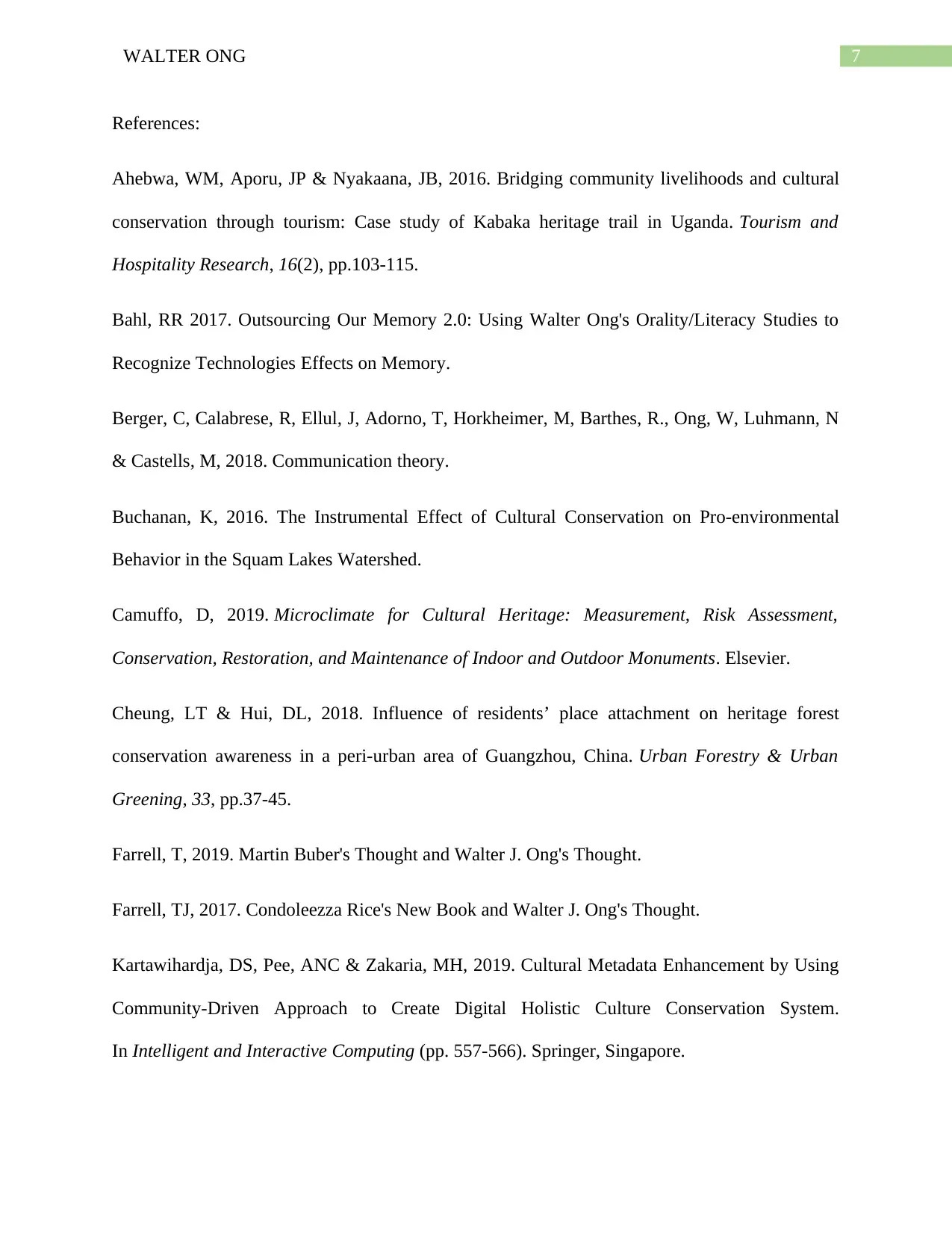
7WALTER ONG
References:
Ahebwa, WM, Aporu, JP & Nyakaana, JB, 2016. Bridging community livelihoods and cultural
conservation through tourism: Case study of Kabaka heritage trail in Uganda. Tourism and
Hospitality Research, 16(2), pp.103-115.
Bahl, RR 2017. Outsourcing Our Memory 2.0: Using Walter Ong's Orality/Literacy Studies to
Recognize Technologies Effects on Memory.
Berger, C, Calabrese, R, Ellul, J, Adorno, T, Horkheimer, M, Barthes, R., Ong, W, Luhmann, N
& Castells, M, 2018. Communication theory.
Buchanan, K, 2016. The Instrumental Effect of Cultural Conservation on Pro-environmental
Behavior in the Squam Lakes Watershed.
Camuffo, D, 2019. Microclimate for Cultural Heritage: Measurement, Risk Assessment,
Conservation, Restoration, and Maintenance of Indoor and Outdoor Monuments. Elsevier.
Cheung, LT & Hui, DL, 2018. Influence of residents’ place attachment on heritage forest
conservation awareness in a peri-urban area of Guangzhou, China. Urban Forestry & Urban
Greening, 33, pp.37-45.
Farrell, T, 2019. Martin Buber's Thought and Walter J. Ong's Thought.
Farrell, TJ, 2017. Condoleezza Rice's New Book and Walter J. Ong's Thought.
Kartawihardja, DS, Pee, ANC & Zakaria, MH, 2019. Cultural Metadata Enhancement by Using
Community-Driven Approach to Create Digital Holistic Culture Conservation System.
In Intelligent and Interactive Computing (pp. 557-566). Springer, Singapore.
References:
Ahebwa, WM, Aporu, JP & Nyakaana, JB, 2016. Bridging community livelihoods and cultural
conservation through tourism: Case study of Kabaka heritage trail in Uganda. Tourism and
Hospitality Research, 16(2), pp.103-115.
Bahl, RR 2017. Outsourcing Our Memory 2.0: Using Walter Ong's Orality/Literacy Studies to
Recognize Technologies Effects on Memory.
Berger, C, Calabrese, R, Ellul, J, Adorno, T, Horkheimer, M, Barthes, R., Ong, W, Luhmann, N
& Castells, M, 2018. Communication theory.
Buchanan, K, 2016. The Instrumental Effect of Cultural Conservation on Pro-environmental
Behavior in the Squam Lakes Watershed.
Camuffo, D, 2019. Microclimate for Cultural Heritage: Measurement, Risk Assessment,
Conservation, Restoration, and Maintenance of Indoor and Outdoor Monuments. Elsevier.
Cheung, LT & Hui, DL, 2018. Influence of residents’ place attachment on heritage forest
conservation awareness in a peri-urban area of Guangzhou, China. Urban Forestry & Urban
Greening, 33, pp.37-45.
Farrell, T, 2019. Martin Buber's Thought and Walter J. Ong's Thought.
Farrell, TJ, 2017. Condoleezza Rice's New Book and Walter J. Ong's Thought.
Kartawihardja, DS, Pee, ANC & Zakaria, MH, 2019. Cultural Metadata Enhancement by Using
Community-Driven Approach to Create Digital Holistic Culture Conservation System.
In Intelligent and Interactive Computing (pp. 557-566). Springer, Singapore.
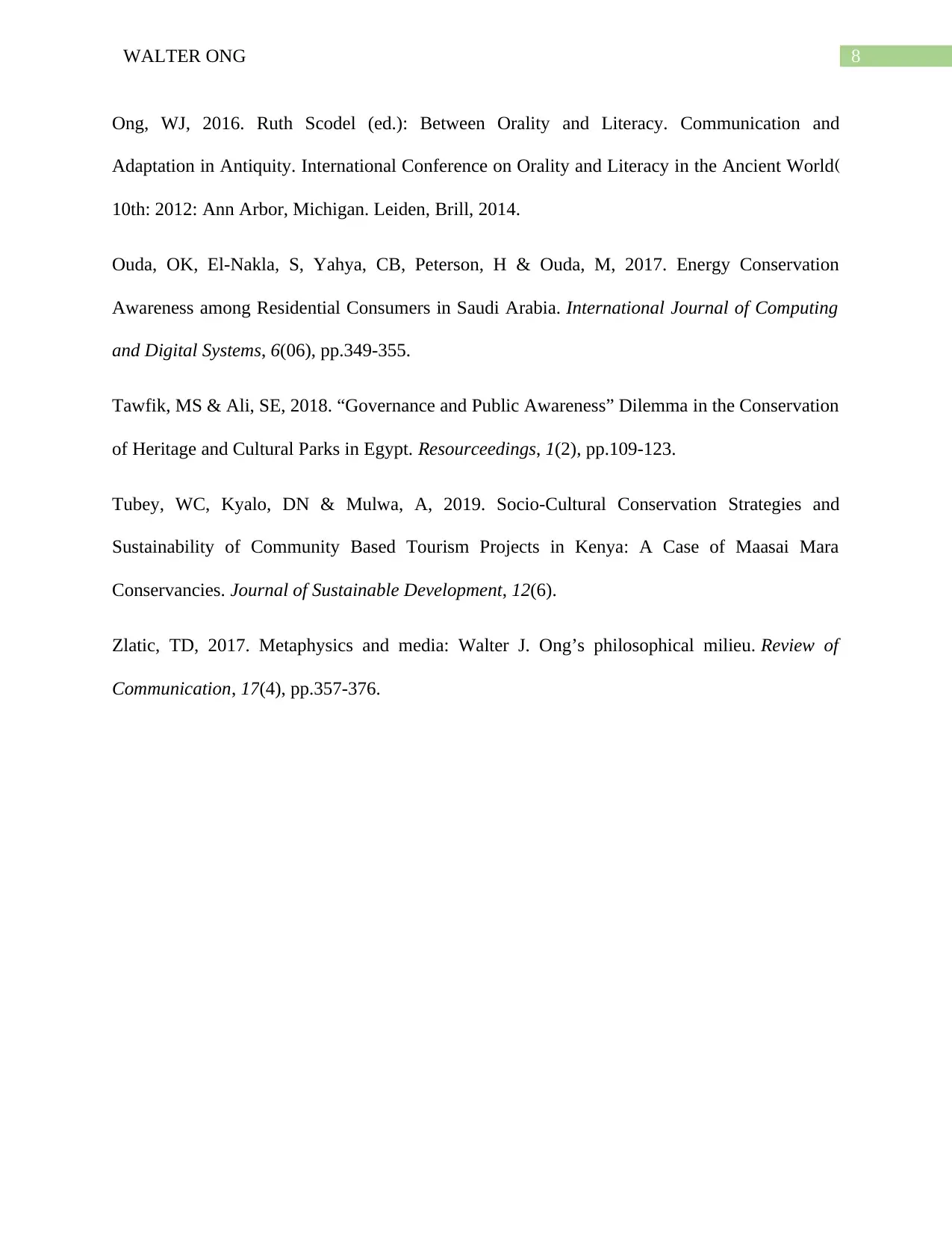
8WALTER ONG
Ong, WJ, 2016. Ruth Scodel (ed.): Between Orality and Literacy. Communication and
Adaptation in Antiquity. International Conference on Orality and Literacy in the Ancient World
10th: 2012: Ann Arbor, Michigan. Leiden, Brill, 2014.
Ouda, OK, El-Nakla, S, Yahya, CB, Peterson, H & Ouda, M, 2017. Energy Conservation
Awareness among Residential Consumers in Saudi Arabia. International Journal of Computing
and Digital Systems, 6(06), pp.349-355.
Tawfik, MS & Ali, SE, 2018. “Governance and Public Awareness” Dilemma in the Conservation
of Heritage and Cultural Parks in Egypt. Resourceedings, 1(2), pp.109-123.
Tubey, WC, Kyalo, DN & Mulwa, A, 2019. Socio-Cultural Conservation Strategies and
Sustainability of Community Based Tourism Projects in Kenya: A Case of Maasai Mara
Conservancies. Journal of Sustainable Development, 12(6).
Zlatic, TD, 2017. Metaphysics and media: Walter J. Ong’s philosophical milieu. Review of
Communication, 17(4), pp.357-376.
Ong, WJ, 2016. Ruth Scodel (ed.): Between Orality and Literacy. Communication and
Adaptation in Antiquity. International Conference on Orality and Literacy in the Ancient World
10th: 2012: Ann Arbor, Michigan. Leiden, Brill, 2014.
Ouda, OK, El-Nakla, S, Yahya, CB, Peterson, H & Ouda, M, 2017. Energy Conservation
Awareness among Residential Consumers in Saudi Arabia. International Journal of Computing
and Digital Systems, 6(06), pp.349-355.
Tawfik, MS & Ali, SE, 2018. “Governance and Public Awareness” Dilemma in the Conservation
of Heritage and Cultural Parks in Egypt. Resourceedings, 1(2), pp.109-123.
Tubey, WC, Kyalo, DN & Mulwa, A, 2019. Socio-Cultural Conservation Strategies and
Sustainability of Community Based Tourism Projects in Kenya: A Case of Maasai Mara
Conservancies. Journal of Sustainable Development, 12(6).
Zlatic, TD, 2017. Metaphysics and media: Walter J. Ong’s philosophical milieu. Review of
Communication, 17(4), pp.357-376.
⊘ This is a preview!⊘
Do you want full access?
Subscribe today to unlock all pages.

Trusted by 1+ million students worldwide
1 out of 9
Your All-in-One AI-Powered Toolkit for Academic Success.
+13062052269
info@desklib.com
Available 24*7 on WhatsApp / Email
![[object Object]](/_next/static/media/star-bottom.7253800d.svg)
Unlock your academic potential
Copyright © 2020–2025 A2Z Services. All Rights Reserved. Developed and managed by ZUCOL.

